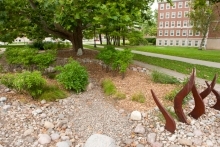You are here
Rain Gardens on Campus (Ongoing)
Recent Project Updates
-
1/21/2020An effective rain garden is planted with suitable trees, shrubs, flowers, and other plants that allow runoff to soak into the ground and protect water quality. Please join us for a presentation by Kaizad Irani on rain gardens from the landscape...
-
9/11/2018Eliana Brown, Extension Stormwater Specialist, and Katy Kraszewska, Department of Landscape Architecture, will lead you through the basics of rain garden design for your home. This workshop will take place on September 13th from 6:30-8pm in the...
Project Family
Associated Collections
Themes
-
Primary Theme:
Other Themes:
Project Location(s)
This map is interactive! Click (or touch) and drag to pan; scroll (or pinch) to zoom.

